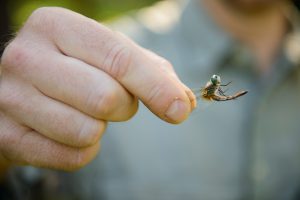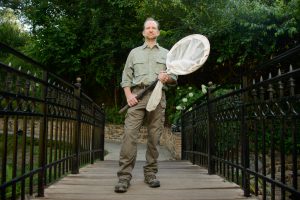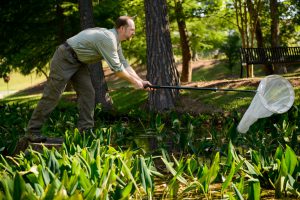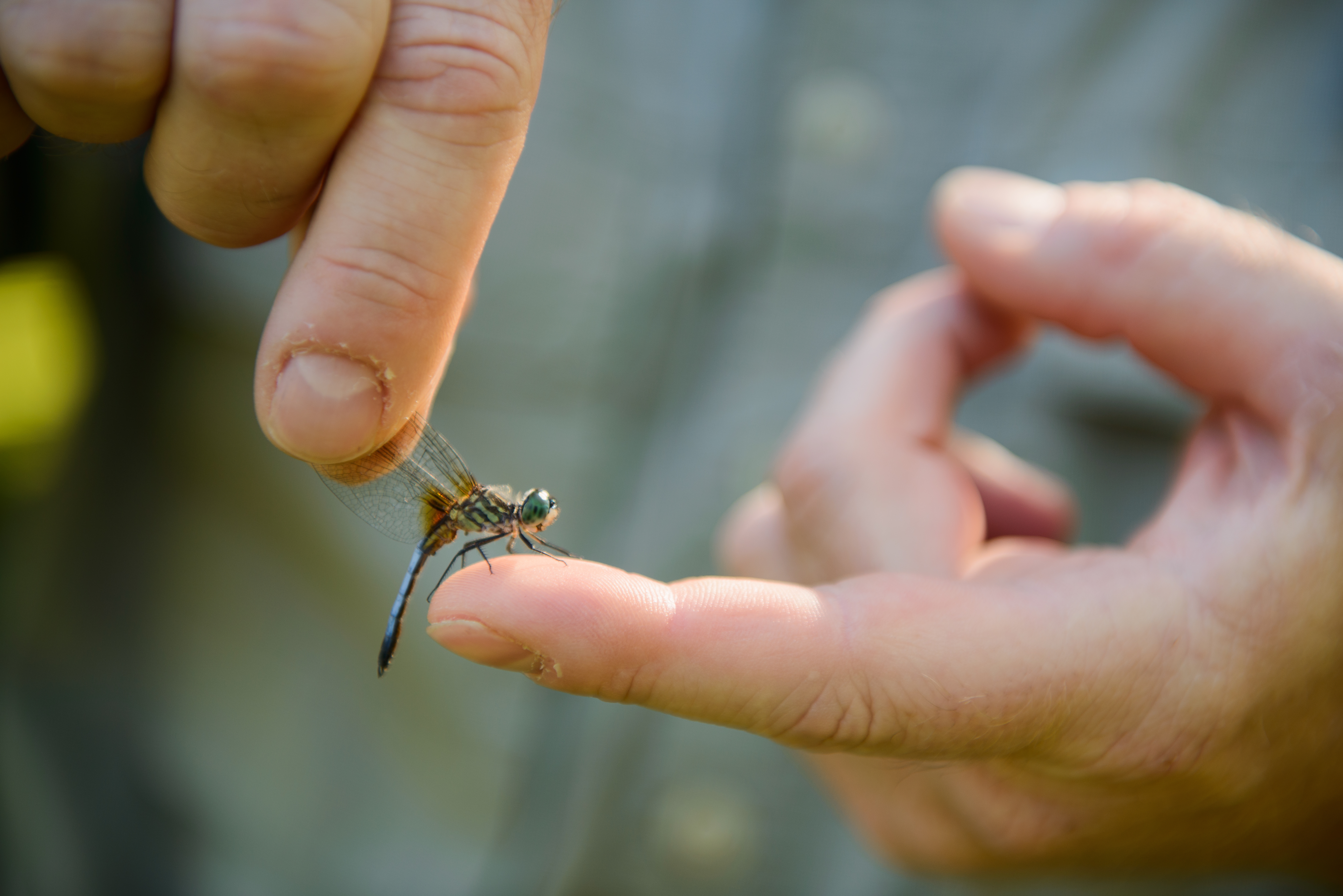By Jamon Smith
Photos by Matthew Wood

Zipping through the sky on two pairs of fast-beating, buzzing, gossamer wings, two blue dasher dragonflies collided into one another in aerial combat above a small pond at the historic landmark of Marr’s Spring on The University of Alabama’s campus.
One of the dragonflies spread its six, spindly, finger-like legs as it dove toward the rival odonate – odonata is an order of carnivorous insects that includes dragonflies and damselflies. Within the span of a second, it clutched its opponent within a cage of its spiny black legs.
The grappled blue dasher struggled to escape, turning its large compound-eyed head in what could only be perceived as dismay.
Seconds passed.
The snared dragonfly finally broke free, likely with a few imperceptible chunks of its electric blue, chitinous flesh bitten off. It flew a few feet away to alight atop the tip of a thick, leafy green arrowhead water plant in a more narrow part of the pond.
It was obviously a bad day for the blue dasher. As soon as it landed, another much larger predator locked his eyes on it. In one, lightning-fast, fell swoop, Dr. John Abbott swiped his net toward it, ensnaring it in the white mesh thread.

Abbot grabbed the blue dasher and placed it on one of his fingertips. It stood there for a split second before flying off, finally free of its harrowing ordeal – for the moment at least.
“Dragonflies are just an amazing group of insects,” Abbott says. “They are one of the most primitive winged insects, and their ancestors had wingspans of 30 inches.”
Dragonflies today have wingspans ranging from less than an inch to 7 1/2 inches. They use their wings to fly at speeds of up to 35 mph and are arguably the fastest flying insect in the world, Abbott says. Some dragonfly species, such as the Wandering Glider, make migratory flights as far as 11,000 miles, flying from continent to continent.
“They’re the first aerial predators,” he says. “Birds and dinosaurs came way after. They’ve gotten smaller than their ancestors, but their morphology is largely the same.”
Abbott, who is director of museum research and collections at The University of Alabama Museums, has studied odonatas since 1989 when he was an undergraduate at Texas A&M University majoring in entomology and zoology.
He received his doctorate from the University of North Texas in 1999 and has since written three books on odonatas: “Dragonflies and Damselflies of Texas and the South-Central United States,” “A Field Guide to Dragonflies in Texas,” and “A Field Guide to Damselflies in Texas.”
“I’ve always been interested in insects since I was a little kid. When I was at Texas Academy of Mathematics and Science at the University of North Texas, a graduate student pointed a dragonfly out to me, saying, ‘this is a group that few people are working on … you should study them.’

“This opened my eyes to this group. When I started to focus on them a little bit I just became absolutely enthralled with learning as much about them as I could. They’re rapidly becoming a popular group of insects for insect enthusiasts.”
Even in their wingless, aquatic, nymph form – the immature part of a dragonfly’s life cycle – dragonflies are voracious predators. As nymphs, they hunt beneath the surface of calm waters such as ponds or streams, eating whatever their hinged, retractable lower jaws can snag, even if it’s the same size or larger than the nymph.
“Their primary prey are biting flies, such as mosquito larvae and other pest insects,” Abbott says. “So they’re beneficial, which is really important right now with mosquito-borne diseases like the Zika virus becoming more prevalent.”
“Some of the nymphs eat newts, salamanders and small fish. The larger adult dragonflies can even eat humming birds.”
For the past 15 years, Abbott has run a website he created called OdonataCentral. The site allows odonata enthusiasts – “citizen scientists” – to view, help identify and upload photos of dragonflies and damselflies documenting their distribution. The site has more than 300,000 images of odonates, and an expert vets each record, so enthusiasts are working right alongside professional scientists.

Last September, Abbott, and a few of his colleagues at Rutgers University, applied for a highly competitive National Science Foundation federal grant with hopes of using the money to create a platform using machine learning to classify existing taxa and flag potential new ones from photographs.
Incorporated with OdonataCentral, this will be the first time such a resource has been created and made available for insect identification. This technology is similar to facial recognition technology.
Earlier this year, they were awarded the grant. The program they’re creating is called Odomatic, and it will be completed in about three years.
“I’m looking forward to working on this,” he says. “I’m very excited about this new feature being added to OdonataCentral and the data that it is going to generate.
“In order for a program like this to work, you have to already have a library of images that have been identified in order to train the software. So the citizen scientists’ photos already submitted are not only providing distributional data for species, but they will be used to train this software to identify future dragonflies and damselflies.
“There are many citizen scientist sites out there for butterflies and other insects. This program can be expanded to other groups besides dragonflies.”
